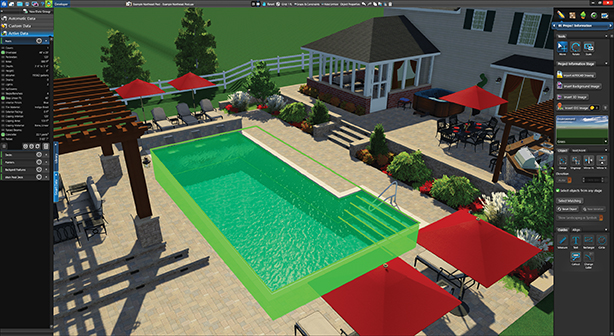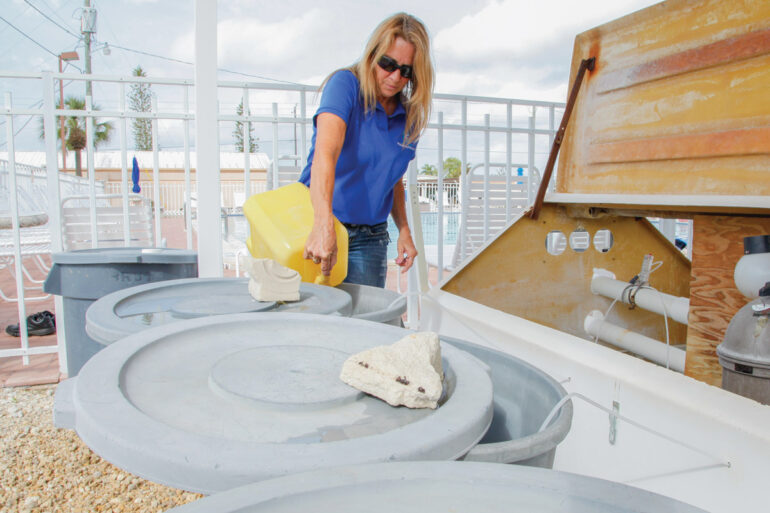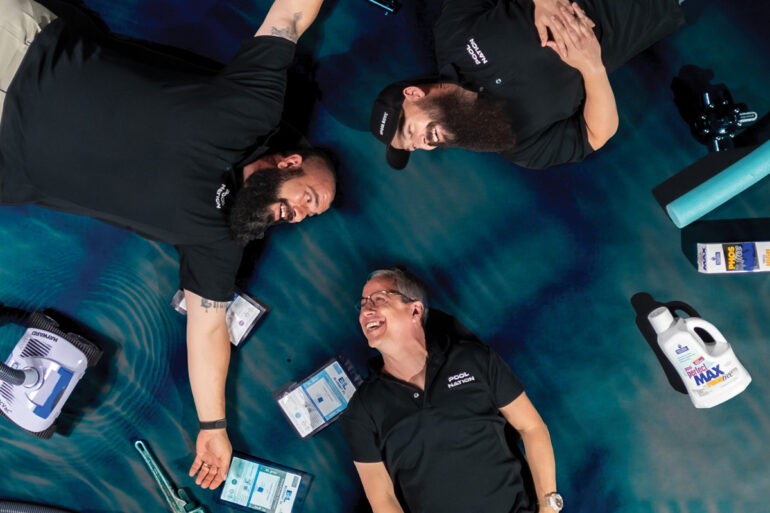By Your Estimation

Pool construction in the United States is a $12 billion industry. According to global research firm IBISWorld, pool builders rely “much more heavily on the skill and knowledge of trained employees than the productive capabilities of machinery or technology.”
At no time is this more true than during the estimation process.
Although exciting new technology enables pool builders to develop estimates that are increasingly accurate and precise, no software or modeling program can replace the foundational principles of transparency, communication, honesty and experience.
Estimating the Unknown: The Cost of Hidden Obstacles
Information is the key to estimation. Like icebergs that threaten ships at sea, most of the issues waiting to sink an estimate lurk hidden beneath the surface.
“You give estimates on the visual elements you can see,” says Mike Giovanone, owner of Concord Pools and Spas in Latham and Saratoga Springs, New York. “But you also estimate the costs of what you can’t see.”
Because unforeseen challenges can quickly turn into unforeseen expenses, builders must gather as much information as humanly possible before discussing cost.
“You can’t go out and just hope you’re right,” Giovanone says.
Hidden surprises could be as simple as underground rocks or a buried stump, but construction crews may also encounter massive obstacles like buried debris dumps, septic systems, leach fields or gas and electric infrastructure.
“Always call underground utility locating services,” Giovanone says. “Make sure you’re not going to tear a 7,000-pound fiber-optic cable.”
Greg Smith, owner of The Swimming Man in Austin, Texas, prides himself on his knowledge of Austin soil, but if he encounters unfamiliar composition that could compromise the integrity of a project and drive up an estimate, he leaves nothing to chance.
“If I’m dealing with an unknown soil, I hire a geotech report engineer to do soil samples,” Smith says.
Estimates on renovations can be even trickier, requiring builders to travel back in time.
“If a 20-year-old pool is in development,” Giovanone says, “you have to think back to what the grade looked like 20 years ago. Twenty years ago, it could have been a farmer’s field. Now everything might flow toward the pool. Think of the upbringing of this pool structure. What were the conditions decades ago? What was the technology? The techniques? The tools?”
Information is a builder’s surest weapon in the war against inaccurate estimates.
“Find out how the existing pool was built, including the subsurface,” Giovanone says. “Examine any existing paperwork. Go to the foundation, see if there’s water in the cellar. Are the walls structurally solid? What kind of bottom does the pool have? Is there corrosion behind the liner? Will it collapse when you pump the water out?”
From Pencil and Paper to 3-D Imaging: The Evolution of Estimation
A new generation of sophisticated software is revolutionizing an industry whose professionals have long scratched out estimates on spreadsheets and Word docs.
“When we first entered the industry, our No. 1 competition was the pencil,” says Noah Nehlich, founder of Pool Studio, a 3-D modeling design software application used by thousands of pool builders worldwide.
“Our software gives builders accurate measurements on which to build estimates,” Nehlich says. “Because they have easy access to those measurements from step one of the process, they have a full grasp of the numbers before they give those numbers to the customer, so there is no sticker shock.”
With Pool Studio, builders can bring their customers’ ideas to life. During estimation, 3-D models show in granular detail where every dollar is being spent. Moving beyond perimeters, gallons and square footage, a new version includes extras like step risers, dirt displacement and the historically tricky calculation of rebar.
For an industry that has traditionally relied on two-dimensional drawings, spreadsheets and verbal discussions, these new tools are changing the estimation game.
“The pool industry had no way of showing a homeowner or client what the second-largest investment of their life would look like until it was done,” Nehlich says. “A car you get to sit in and test drive, but a pool, you just had to trust the guy who was building it. Now, builders can help them understand the value of upgrades.”
This ability to convey value opens new doors to upselling during estimation. According to Nehlich, builders who use Pool Studio report an increase of 20 to 30 percent in per-project sales.
By using 3-D modeling to show how much space furniture takes up, for example, builders can sell bigger decks. Models help articulate concepts that can be difficult to explain, such as dirt displacement for sunken patios. In other cases, models can convey the sheer aesthetic beauty of laminar jets or fire pits more powerfully than words ever could.
Evosus, a point-of-sale and business management software suite, does more than help pool builders create estimates — it helps them manage and stay within those estimates as work progresses.
“Pool builders aren’t using the software to figure out how much to charge,” says Christina Braks, vice president of operations at Evosus. “They use the software to stay within their estimated budgets, to control costs and manage on-the-job expenses.”
Evosus enables builders to catalogue all costs — including raw materials, concrete, labor and overhead — in real time, immediately alerting all stakeholders if one phase of the job has gone over budget.
“Cost control and visibility is something that everyone involved enjoys in real time as the data are entered,” says Jessica Chase, vice president of client services for Evosus. “Subcontractor costs, by-phase costs, heaters, pumps, PVC and inventory are all calculated as they are used on the job. Before, all these elements would be entered simply as ‘construction.’ ”
Nicole Ragel of Patio Pools & Spas in Tucson, Arizona, uses Evosus to collaborate with customers in building a personalized pool starting with a
boilerplate template.
“We can say, ‘Here is the base pool,’ then add decking, options, add a light, add a floor system, upgrade the pump,’ ” Ragel says. “The software tracks every option, and by the time I’m done, I have a parts list, budget per phase, permit cost — every step of that job is lined out. As we’re building, our actuals go into the same system and I can see if I’m on target, over or under.”
RB Control Systems is a point-of-sale and business management program that helps more than 750 builders across the United States and Canada create, explain and stay within estimates by consolidating the clutter of spreadsheets and Word docs. This is especially important on large, time-consuming jobs, where individual expenditures often fall through the cracks.
Tyler Brandt, who leads the concept and design team, says the software helps builders develop estimates, create quotes and track work progress all within one unified platform.
“Builders can identify variances as they go,” Brandt says. “If a $3,000 excavation job comes back at $3,500, they will know right away. They can organize and itemize every expense: gas to and from the job site, equipment rentals, trips to Home Depot, installation, specialty work.”
The Fundamentals: Some Things Never Change
Software can help builders gather, organize and convey crucial information. It can help them project probable costs and closely monitor those costs during work. Software can even enable builders with no tech background to create compelling and accurate 3-D displays that perfectly mimic a real-life project.
No software, however, can replace the foundational elements on which every estimate should be based: honesty, transparency, common sense and unrelenting commitment to the best interests of every customer.
“If you’re not listening, you’re going to build something that isn’t their dream pool,” Ragel says. “Pick up on what is important, what isn’t, and identify what they’re truly looking for. Help educate them and lead them down the right path to find their right budget.”
“If you’re in the pool business, you’re in the people business,” says Giovanone, who says he will forfeit a sale and instead suggest filling in an existing pool if he doesn’t think a renovation is worth the money. “I don’t have customers. I have cust-owners. They are part of my business, part of my company.”
Giovanone never gives an estimate when the customer is not home because having the homeowner present assures him the customer understands every single dollar item in the estimate. Smith agrees.
“I calculate everything,” he says. “Overhead, profit, work. I line item anything that has the potential to cost a single dollar. Give them an education as you give the estimate. Explain liabilities and assets. A traditional pump costs $500. I explain that a variable speed pump is $950, but it’s 80 percent more efficient, and they’ll get it back on electricity.”
Information is the estimator’s surest defense against mistakes. The more information builders can gather, the more accurate their estimates will be. Transparency is critical — customers should understand every item in the estimate, they should have a clear understanding of potential issues that could emerge along the way and they should receive frequent updates as work progresses so there are no surprises. Exciting new technology is making the process easier and more efficient, but software can never replace the foundational principles that have guided the industry’s top builders for generations.






